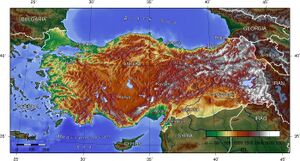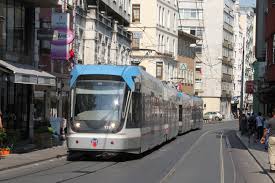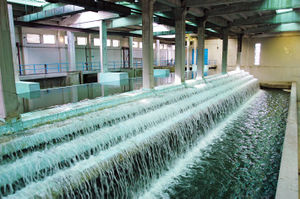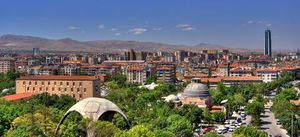
Overview[edit | edit source]
Turkey, one of the fastest growing countries in Europe, has seen a drastic increase in population in the last 20 years, reports The World Bank Group. As a result, the country's modern developers, engineers and government officials have had trouble trying to keep up with the sustainability issues associated with rapid urbanization. According to the United Nations Development Program in Turkey, the urbanization rate has increased from 52.9 percent in 1990 to 74.9 percent in 2008. This change has brought with it a number of infrastructure problems that must be addressed in order for the larger cities of Turkey to maintain livability for future generations. Below are some solutions that three Turkish cities have found and the steps they have taken towards urban reform. The majority of these sustainability projects have been overseen by The World Bank's Europe and Central Asia Sustainable Cities Initiative and the United Nations Development Program (UNDP) in Turkey in tandem with other related sections of the Turkish Government.
Example Solutions in Urban Areas[edit | edit source]
- Samsun, Northeast Turkey: The urban transportation system in Samsun has had increased traffic congestion and pollution as a result of urbanization, and it has become necessary to restructure the previous public transportation for a more modern and energy efficient method to service the population. One way this issue has been addressed in Samsun is the recently installed light rail system, allowing rapid transit through the city using electricity propelled trains. The light rail keeps transportation costs moderate for passengers and provides a reliable way to commute. A field study of the city conducted by The World Bank Group [1] in January of 2012 reported that "the new light rail is 16 kilometers long, has 17 stops, cost around €120 million, and connects the Ondokuz Mayıs University Campus to the center of the city along the shore of the Black Sea. The system has enjoyed immediate public response, with a ridership of around 50,000-65,000 passengers per day. A ticket costs 1.5 Turkish Lira (around $0.81) for passengers that use the light rail for less than 10 stations." Samsun has also integrated a privately run Dolmuş bus system to increase the availability of transportation to communities outside of light rail reach.

- Ankara, Central Turkey: Providing citizens with clean drinking water has been an issue for Polatli, a suburb of Ankara. Approximately 100,000 of the town residents did not have access to potable water until a water treatment facility was established in 2007[2]. Before the facility was built, the townspeople had to purchase and transport all of the water for their home use from outside of Polatli. The new treatment facility is able to filter the groundwater and transport the clean water 80 kilometers to the city via a series of underground pipes. Engineers at the facility explain that a series of 216 membranes are what filter the water and separate it from the heavy minerals which are unsafe for consumption. Over the next decade, Ankara plans to address other issues regarding water consumption, such as establishing waste water treatment facilities to prevent the spread of disease and the pollution of other near by water sources like lakes and rivers.

- Konya, Southern Turkey: The sustainable development of buildings has become a top priority for city planners in Konya. Sustainable planning or building techniques were at times ignored in the past, because the demand for more housing was so great that regulations were overlooked in order to speed up construction in urban areas. As a result, maintenance and restructuring was necessary to convert these substandard buildings to sustainable models. Increased urban planning regulation have helped to establish higher density housing structures in the more populated central area of the city, helping to prevent urban sprawl. To address energy efficiency, new buildings and rehabilitated historic districts must abide by modern building codes and regulations, and install energy saving appliances. The UNDP in Turkey is currently working on a project aimed at curbing the energy consumption and emissions of the building sectors throughout Turkey. According to a recent project report on the UNDP website[3], "in terms of final energy consumption, the building sector represents the second-largest energy consumer accounting for 36 percent of the total final energy consumption in 2008 and the building sector's emissions are 32 percent of the total national energy-related CO2 emissions." The city of Konya is obviously taking the necessary steps to address this issue.

Resources[edit | edit source]
- "Promoting Energy Efficiency in Buildings in Turkey." United Nations Development Programme. N.p., 2013. Web. 4 Apr. 2014. http://www.us.undp.org/content/turkey/en/home/operations/projects/environment_and_energy/promoting_energy_efficiency_in_buildings_in_turkey/
- "Sustainable Cities Program & Urbanization Review Workshop." Urbanization Knowledge Partnership. The World Bank Group, 10 Feb. 2012. Web. 4 Apr. 2014. http://web.archive.org/web/20150121174639/http://www.urbanknowledge.org:80/ur/docs/Turkey_Workshop.pdf
- "International Environmental Issues." Republic of Turkey Ministry of Foreign Affairs. N.p., 2011. Web. 4 Apr. 2014. http://www.mfa.gov.tr:80/international-environmental-issues.en.mfa
- Celasin, Tunya. "In Turkey: Clean Water for Growing Cities." The World Bank. N.p., n.d. Web. 4 Apr. 2014. http://web.archive.org/web/20161110231120/http://web.worldbank.org:80/WBSITE/EXTERNAL/COUNTRIES/ECAEXT/0,,contentMDK:23094792~pagePK:146736~piPK:146830~theSitePK:258599,00.html
- Sommer, Yarissa L., and Delphine Hamilton. "Europe and Central Asia: Sustainable Cities Initiative." The World Bank. N.p., 5 June 2013. Web. 4 Apr. 2014. http://www.worldbank.org/en/region/eca/brief/sustainable-cities-initiative